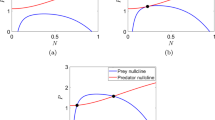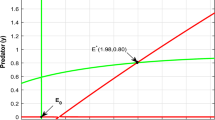Abstract
Non-local reaction–diffusion equation is an important area to study the dynamics of the individuals which compete for resources. In this paper, we describe a prey-dependent predator–prey model with Holling type II functional response with a generalist predator. In particular, we want to see the behavior of the system in the presence of non-local interaction. Introduction of non-local intraspecific competition in prey population leads to some new characteristics in comparison with the local model. Comparisons have been made between the local and non-local interactions of the system. The range of non-local interaction enlarges the parametric domain on which stationary patterns exist. The periodic oscillation for the local model in the Hopf domain can be stabilized by suitable limit of strong non-local interaction. An increase in the range of non-local interaction increases the Turing domain up to a certain level, and then, it decreases. Also, increasing the range of non-local interaction results in the overlap of nearby foraging areas and hence alters the size of the localized patches and formation of multiple stationary patches. Numerical simulations have been carried out to validate the analytical findings and to establish the existence of multiple stationary patterns, oscillatory solution, two-periodic solution and other spatiotemporal dynamics.








Similar content being viewed by others
References
Banerjee M, Abbas S (2015) Existence and non-existence of spatial patterns in a ratio-dependent predator–prey model. Ecol Complex 21:199–214. https://doi.org/10.1016/j.ecocom.2014.05.005
Banerjee M, Volpert V (2016a) Prey–predator model with a nonlocal consumption of prey. Chaos 26:083120. https://doi.org/10.1063/1.4961248
Banerjee M, Volpert V (2016b) Spatio-temporal pattern formation in Rosenzweig–MacArthur model: effect of nonlocal interactions. Ecol Complex 30:2–10. https://doi.org/10.1016/j.ecocom.2016.12.002
Banerjee M, Zhang L (2016) Stabilizing role of nonlocal interaction on spatio-temporal pattern formation. Math Model Nat Phenom 11(5):103–118. https://doi.org/10.1051/mmnp/201611507
Bayliss A, Volpert VA (2017) Complex predator invasion waves in a Holling–Tanner model with nonlocal prey interaction. Physica D 346:37–58. https://doi.org/10.1016/j.physd.2017.02.003
Bessonov N, Reinberg N, Volpert V (2014) Mathematics of Darwins diagram. Math Model Nat Phenom 9(3):525. https://doi.org/10.1051/mmnp/20149302
Britton NF (1990) Spatial structures and periodic travelling waves in an integro-differential reaction–diffusion population model. SIAM J Appl Math 50(6):1663–1688. https://doi.org/10.1137/0150099
Dunbar SR (1983) Travelling wave solutions of diffusive Lotka–Volterra equations. J Math Biol 17:11–32. https://doi.org/10.1007/BF00276112
Ferreira SC Jr, Martins ML, Vilela MJ (2002) Reaction–diffusion model for the growth of avascular tumor. Phys Rev E 65:021907. https://doi.org/10.1103/PhysRevE.65.021907
Fuentes MA, Kuperman MN, Kenkre VM (2003) Nonlocal interaction effects on pattern formation in population dynamics. Phys Rev Lett 91:158104. https://doi.org/10.1103/PhysRevLett.91.158104
Fussmann GF, Ellner SP, Shertzer KW, Hairston NG Jr (2000) Crossing the Hopf bifurcation in a live predator–prey system. Science 290(5495):1358–1360. https://doi.org/10.1126/science.290.5495.1358
Genieys S, Volpert V, Auger P (2006) Pattern and waves for a model in population dynamics with nonlocal consumption of resources. Math Model Nat Phenom 1(1):65–82. https://doi.org/10.1051/mmnp:2006004
Guin LN, Haque M, Mandal PK (2012) The spatial patterns through diffusion-driven instability in a predator–prey model. Appl Math Model 35:1825–1841. https://doi.org/10.1016/j.apm.2011.05.055
Holling CS (1965) The functional response of predators to prey density and its role in mimicry and population regulation. Mem Entomol Soc Canada 97(S45):5–60. https://doi.org/10.4039/entm9745fv
Kenkre VM, Kuperman MN (2003) Applicability of the Fisher equation to bacterial population dynamics. Phys Rev E 67:051921. https://doi.org/10.1103/PhysRevE.67.051921
Petrovskii SV, Malchow H (2001) Wave of chaos: new mechanism of pattern formation in spatio-temporal population dynamics. Theor Popul Biol 35:157–174. https://doi.org/10.1006/tpbi.2000.1509
Segel LA (1972) Dissipative structure: an explanation and an ecological example. J Theor Biol 37(3):545–559. https://doi.org/10.1016/0022-5193(72)90090-2
Segel BL, Volpert VA, Bayliss A (2013) Pattern formation in a model of competing populations with nonlocal interactions. Physica D 253:12–22. https://doi.org/10.1016/j.physd.2013.02.006
Sherratt JA, Eagan BT, Lewis MA (1997) Oscillations and chaos behind predator–prey invasion: mathematical artifact or ecological reality? Philos Trans R Soc Lond B 352:21–38. https://doi.org/10.1098/rstb.1997.0003
Turchin P (2003) Complex population dynamics: a theoretical/empirical synthesis. Princeton University Press, Princeton
Wang W, Liu QX, Jin Z (2007) Spatio-temporal complexity of a ratio-dependent predator–prey system. Phys Rev E 75:051913. https://doi.org/10.1103/PhysRevE.75.051913
Wilson RE, Capasso V (1997) Analysis of a reaction–diffusion system modeling man–environment–man epidemics. SIAM 57:327–346. https://doi.org/10.1137/S0036139995284681
Zhanga JF, Lib WT, Yanc XP (2011) Hopf bifurcation and Turing instability in spatial homogeneous and inhomogeneous predator–prey models. Appl Math Comput 218:1883–1893. https://doi.org/10.1016/j.amc.2011.06.071
Acknowledgements
The work of the first author (S. Pal) is supported by DST INSPIRE FELLOWSHIP, REG. NO. IF150434.
Author information
Authors and Affiliations
Corresponding author
Rights and permissions
About this article
Cite this article
Pal, S., Ghorai, S. & Banerjee, M. Analysis of a Prey–Predator Model with Non-local Interaction in the Prey Population. Bull Math Biol 80, 906–925 (2018). https://doi.org/10.1007/s11538-018-0410-x
Received:
Accepted:
Published:
Issue Date:
DOI: https://doi.org/10.1007/s11538-018-0410-x




